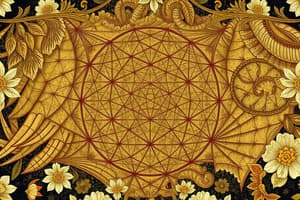Podcast
Questions and Answers
What does set builder notation primarily represent?
What does set builder notation primarily represent?
- The conditions that define the elements of a set (correct)
- The exact numerical values of a domain or range
- The graphical representation of a function
- The sequential order of data in a table
When determining the least x-value for domain representation, which aspect is most crucial?
When determining the least x-value for domain representation, which aspect is most crucial?
- The highest point on the graph along the y-axis
- The value where the graph begins on the x-axis (correct)
- The average of all x-values present in the data
- The slope of the graph at its steepest point
In set builder notation, how is the inclusion of a value expressed?
In set builder notation, how is the inclusion of a value expressed?
- By omitting the value entirely
- By stating the value is less than or equal to another
- Using parentheses around the value
- Using square brackets around the value (correct)
Which of the following best describes the term 'range' in relation to a graph?
Which of the following best describes the term 'range' in relation to a graph?
What is the primary purpose of scanning from bottom to top along the y-axis when determining the range?
What is the primary purpose of scanning from bottom to top along the y-axis when determining the range?
What does the domain of a function represent?
What does the domain of a function represent?
Which of the following describes a continuous graph?
Which of the following describes a continuous graph?
How is the range of a function best described?
How is the range of a function best described?
In which form is the domain of a discrete function typically expressed?
In which form is the domain of a discrete function typically expressed?
What would a graph with no restrictions on values likely indicate about its domain?
What would a graph with no restrictions on values likely indicate about its domain?
When determining the domain of a continuous graph, what axis should you scan?
When determining the domain of a continuous graph, what axis should you scan?
Which statement about set builder notation is correct for the range of a function?
Which statement about set builder notation is correct for the range of a function?
What does it mean if a set of ordered pairs does not represent a function?
What does it mean if a set of ordered pairs does not represent a function?
Which symbol is used in set builder notation to indicate a closed interval where the endpoint is included?
Which symbol is used in set builder notation to indicate a closed interval where the endpoint is included?
How would you represent the domain of the function if it includes the endpoints in set builder notation?
How would you represent the domain of the function if it includes the endpoints in set builder notation?
Given a graph where the least x-value is included and the greatest x-value is not included, which set builder notation is correct?
Given a graph where the least x-value is included and the greatest x-value is not included, which set builder notation is correct?
What is the purpose of using interval or set builder notation for domains and ranges?
What is the purpose of using interval or set builder notation for domains and ranges?
If a graph has an open circle at a x-value, how does it affect the set builder notation for the domain?
If a graph has an open circle at a x-value, how does it affect the set builder notation for the domain?
What symbol represents an open interval in set builder notation?
What symbol represents an open interval in set builder notation?
Which of the following correctly represents a situation where the least y-value is not included and the greatest y-value is included?
Which of the following correctly represents a situation where the least y-value is not included and the greatest y-value is included?
When using interval notation for a domain that extends indefinitely towards negative infinity and includes -3, what would be its representation?
When using interval notation for a domain that extends indefinitely towards negative infinity and includes -3, what would be its representation?
Flashcards
Domain of a function
Domain of a function
The set of all possible input values (x-values) that can be plugged into a function.
Range of a function
Range of a function
The set of all possible output values (y-values) that a function can produce.
Function
Function
A function is a set of ordered pairs where no two different ordered pairs have the same first element.
Vertical Line Test
Vertical Line Test
Signup and view all the flashcards
Table as a Function
Table as a Function
Signup and view all the flashcards
Domain
Domain
Signup and view all the flashcards
Range
Range
Signup and view all the flashcards
Set-builder Notation
Set-builder Notation
Signup and view all the flashcards
Set Builder Notation for Domain and Range
Set Builder Notation for Domain and Range
Signup and view all the flashcards
Closed Endpoint in Set Builder Notation
Closed Endpoint in Set Builder Notation
Signup and view all the flashcards
Open Endpoint in Set Builder Notation
Open Endpoint in Set Builder Notation
Signup and view all the flashcards
Least x-value
Least x-value
Signup and view all the flashcards
Greatest x-value
Greatest x-value
Signup and view all the flashcards
What is the Domain?
What is the Domain?
Signup and view all the flashcards
What is the Range?
What is the Range?
Signup and view all the flashcards
How do we write Domain and Range?
How do we write Domain and Range?
Signup and view all the flashcards
What is the independent variable?
What is the independent variable?
Signup and view all the flashcards
What is the dependent variable?
What is the dependent variable?
Signup and view all the flashcards
How to determine the domain of a continuous graph?
How to determine the domain of a continuous graph?
Signup and view all the flashcards
How to determine the range of a continuous graph?
How to determine the range of a continuous graph?
Signup and view all the flashcards
What is a function?
What is a function?
Signup and view all the flashcards
Study Notes
Domain and Range Notes
-
Domain: The set of all input values (x-values) for a function. These values correspond to the points on the graph's x-axis.
-
Range: The set of all output values (y-values) for a function. These values correspond to the points on the graph's y-axis.
Writing Domain and Range
-
Discrete (Finite) Graphs: Domain and range consist of separate, distinct values. These are often represented by lists of numbers or points, like ordered pairs, tables, mappings, or scatter plots.
-
Continuous Graphs: The domain and range can be infinite and are often expressed as intervals or set-builder notation. A continuous graph is one that you can draw without lifting your pencil. These graphs can include lines, curves, or combinations of those.
Set Builder Notation
- Use symbols like "x ∈" (x is an element of), "such that" or "≥" (greater than or equal to), "<" (less than), ">=" (greater than or equal to), and "<=" (less than or equal to) to describe the conditions for the domain and/or range.
Interval Notation
- Uses parentheses and brackets to show whether or not endpoints are included in the interval. Parentheses exclude the endpoint (e.g., (2, 5) means the values between 2 and 5 but not including 2 or 5 themselves). Brackets include the endpoint (e.g., [2, 5] means all the values between 2 and 5, including 2 and 5).
Graphing to Find Domain and Range
- Continuous graphs: Use the x-axis to determine the domain (scanning from left to right). Use the y-axis to determine the range (scanning from bottom to top).
- Discrete graphs: Identify all the separate points on the graph. The x-coordinates represent the domain, and the y-coordinates represent the range.
Examples (from document)
- Examples of discrete and continuous graphs, tables, mappings and ordered pairs show different ways to represent domains and ranges.
Studying That Suits You
Use AI to generate personalized quizzes and flashcards to suit your learning preferences.




